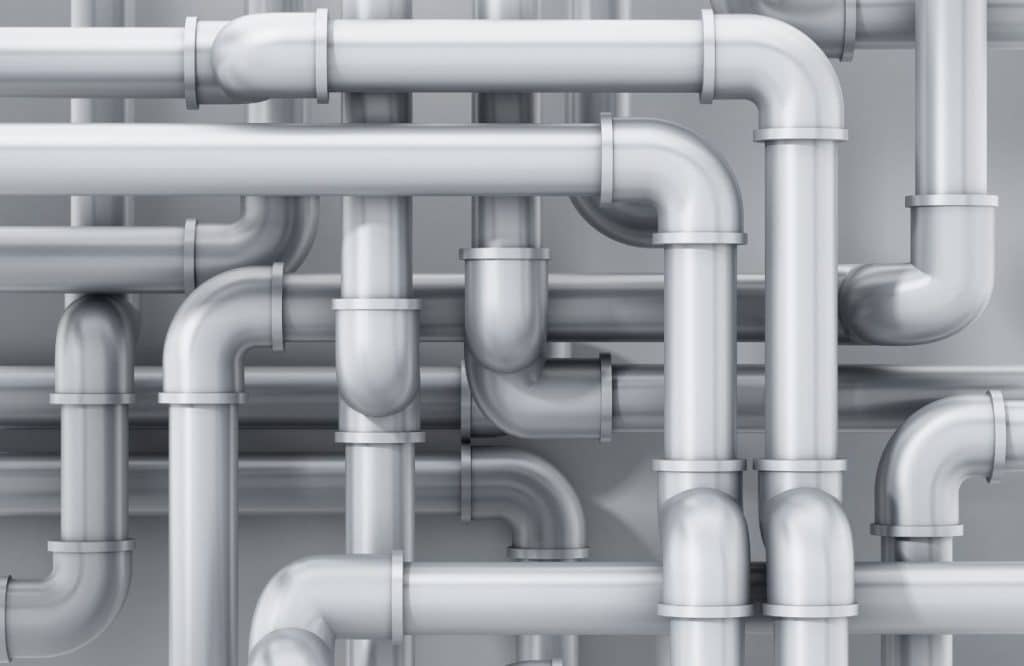Things change: Teams, processes, and revenue all evolve over time. For healthcare and industrial facilities alike, this change can be hard to keep up with—both internally and externally. Operational, safety, and infrastructure costs are magnified by change. Often much of these costs could be mitigated with better system intelligence. The critical piping systems facilities rely on are often misrepresented by out-of-date pipe drawings and inaccurate assessments. Dusty documents sitting on a shelf don’t do much for you or your facility.
In a recent webinar, “Backflow & Beyond: Trends in Cross-Connection Control,” HydroCorp’s Gary McLaren discussed the importance of reliable piping schematics along with other key trends in regulations, survey findings, and more.
Backflow & Beyond: Trends in Cross-Connection Control
The Piping Problem
Facilities—from hospitals to manufacturing—have intricate piping systems that carry more than just potable water. Revenue loss can occur when a piping system causes downtime, safety incidents, or worse. From deadly medical gas accidents to food processing contamination, the question becomes, “How could we not have known the piping system had this problem?”
On average, HydroCorp finds that many facilities have pipe drawings, maps or diagrams that are over 5 years old. To compound the problem, facilities aren’t stagnant. “The cycle where things start to change in a noticeable way for a potable water system in a hospital or some sort of industrial facility is about 18 months,” McLaren says. “The schematics should reflect that,” but without regular updates, they don’t.
Taken together with the sheer quantity of pipe and valves (typically, there are anywhere from 15 to 50 valves per 500 feet of hospital piping) that’s a large knowledge gap in any facility. “We often find that hospitals and industrial facilities don’t know where approximately 20% of the valves are.”
As facilities increasingly understand their piping problem, the need for reliable pipe drawings becomes clear. How can you respond in an emergency if you don’t know what runs through which pipe and how to turn it off? How can you protect your system and prevent contamination of the potable water supply?
Filling the Knowledge Gap
So, what’s the solution? To fix the problem of out-of-date or nonexistent piping schematics, facilities are beginning to invest time and resources in creating and maintaining detailed, reliable, pipe drawings. “We are seeing a trend with more healthcare facilities and industrial facilities addressing the topic and pushing the envelope of updating existing information,” McLaren explains.
What does reliable mean? “The only way to keep [schematics] reliable is to routinely update them—within about that 18-month cycle,” McLaren says. You do so “by physically updating and visually verifying” through on-site surveys that confirm the system is properly reflected in the schematics. In smaller facilities or where stringent budget constraints exist, piping schematics may not be attainable. However, a periodical visual survey and documentation is, at minimum, the best approach to avoiding costly problems.
How to Use
Up-to-date pipe drawings act as “a dynamic operational tool used by multiple teams and departments.” For pipe drawings to be truly helpful, they must be accurate, accessible, and informative across operational areas within your facility. And to get the most out of your piping schematics, they should be a regularly used tool—not sitting on a shelf collecting dust.
Maintenance, planning, and operational teams alike can use the drawings to provide critical insight into what’s happening in the facility, where processes and systems can be more efficient, and how to respond in an emergency. “When we have an incident, that’s where this information becomes very useful, effective, and valuable,” says McLaren. “A reliable piping schematic really should be a day-to-day tool for facilities.”
From effectively planning facility expansions to cutting costs by identifying inefficient infrastructure to shutting off the right valve the first time, schematics are invaluable when they are reliable and used to their fullest potential.
How to Create
When your teams depend on piping schematics, they need to be detailed in addition to being accurate. Conducting a full-scale visual survey and mapping out the piping infrastructure is the only way to get all the information you need to create an effective tool.
Effective pipe drawings should include:
- System flow directions and labeling
- Valve tag references and labeling
- Legend with color-coded references
- Backflow preventer locations and types
- Pressure reducers and regulators
- Emergency shut-off valves
- Points of use and connections
The Impact of Reliable Pipe Drawings
“When we talk about piping schematics, there’s a definite ROI,” McLaren says. Not only do they help facilities avoid costly scenarios in emergency breakdowns, but they enable operational efficiency and support expansion or renovation plans. Accurate, reliable pipe drawings help you limit lost revenue and know exactly what and how much of any materials you need when updating plumbing in your facility. Whether you’re looking at maintenance or expansion, good schematics go a long way.
Ready to learn more about how HydroCorp can support your facility through on-site surveys and the development of reliable piping schematics?


